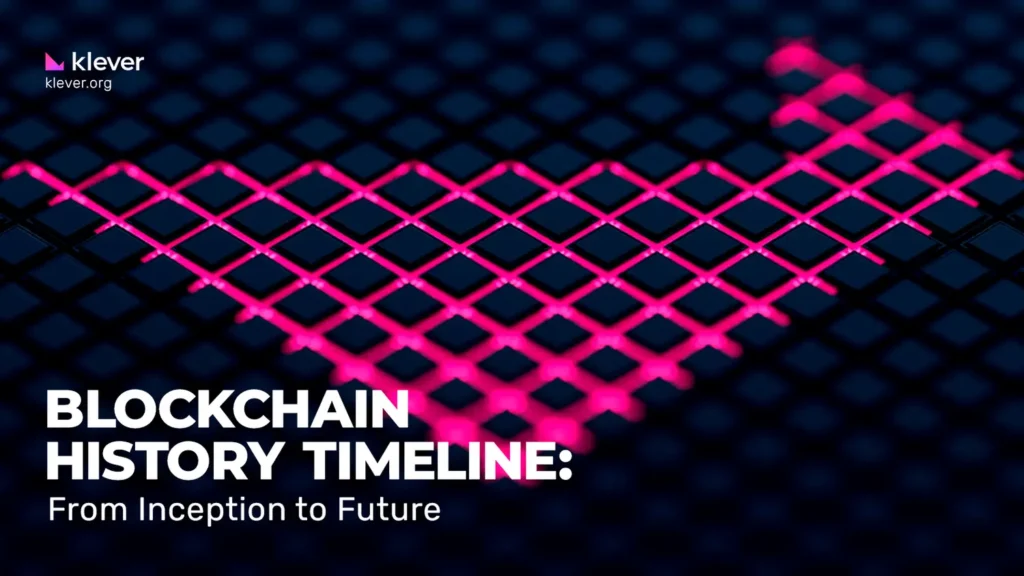
Blockchain technology has revolutionized the digital world, providing a secure and transparent way to record transactions. But how did it all start? Let’s embark on a journey through the definitive timeline of blockchain history, from its inception to the present day, and even a glimpse into the future.
Blockchain History

The First Blockchain Concept (1991-1992)
The first blockchain concept was introduced in 1991 when Stuart Haber and Wakefield Scott Stornetta proposed a system where document timestamps could not be tampered with. So, in 1992, they incorporated Merkle Trees into the design, allowing several documents to be collected into one block, enhancing efficiency and security.
Cryptographic Secured Chains (2000)
In 2000, Stefan Konst published a paper describing cryptographically secured chains, a concept that closely resembles today’s blockchain. However, it wasn’t until 2008 that the idea of a decentralized, secure database was fully realized.
Hal Finney and the Digital Cash System (2004)
In 2004, Hal Finney, a renowned cryptographic activist, introduced a system for digital cash known as “Reusable Proof of Work” (RPoW). Specifically, this system created a transferrable RSA-signed token based on a non-exchangeable hash cash proof-of-work (PoW) token. Finney’s RPoW was a significant step towards solving the double-spending problem, a common issue in digital cash systems, and laid the groundwork for the development of Bitcoin.
The Birth of Bitcoin (2008-2009)
In 2008, an individual (or group) under the pseudonym Satoshi Nakamoto conceptualized the first blockchain. A year later, Nakamoto implemented this as a core component of Bitcoin, a digital currency. As a result, this marked the birth of the first fully functional blockchain.
The First Bitcoin Transaction (2010)
In 2010, the first commercial cryptocurrency transaction occurred when 10,000 Bitcoins were exchanged for two pizzas. This marked the first real-world Bitcoin transaction, setting the stage for Bitcoin’s future growth.
The Emergence of Blockchain 2.0 (2014)
In 2014, the concept of Blockchain 2.0 emerged, marking a pivotal shift from the focus on cryptocurrencies to a broader range of business applications. Moreover, this phase was facilitated by the advent of Blockchain as a Service (BaaS), which simplified the deployment of blockchain technology, making it more accessible to businesses and amplifying blockchain use cases.
The Launch of Ethereum and Hyperledger (2015)
In 2015, the blockchain landscape saw the launch of Ethereum and Hyperledger, two platforms that significantly expanded the potential of blockchain technology. Ethereum enabled developers to write smart contracts and build decentralized applications (dApps), pushing the boundaries of what could be achieved with blockchain.
The DAO Hack (2016)
In 2016, the blockchain community witnessed a significant event – The DAO hack. Hackers attacked The DAO, a decentralized autonomous organization on the Ethereum blockchain, leading to a hard fork in the Ethereum network. Therefore, This incident highlighted the security vulnerabilities in smart contracts and led to significant changes in the blockchain landscape. As a result, the hack resulted in the theft of 3.6 million Ether and caused a split in the Ethereum community, leading to the creation of Ethereum Classic.
The Release of EOS (2017)
In 2017, developers released the EOS blockchain operating system, marking a significant milestone in the history of blockchain. EOS aimed to address some of the scalability and usability issues that plagued earlier blockchain platforms. So, it introduced a new architecture that enabled vertical and horizontal scaling of decentralized applications.
Bitcoin Turns 10 (2018)
2018 marked a major milestone in the history of blockchain as Bitcoin celebrated its 10th anniversary. Over the decade, Bitcoin had grown from a theoretical concept into a globally recognized digital currency. Its underlying technology, blockchain, had also evolved, finding applications in various industries beyond finance.
Ethereum Exceeds 1M Transactions Per Day (2019)
In 2019, the Ethereum network achieved a significant milestone by processing over 1 million blockchain transactions in a single day. Moreover, this achievement was a testament to the scalability of the Ethereum platform and its growing use in various sectors.
The Rise of StableCoins and Ethereum 2.0 (2020)
The year 2020 saw the rise of StableCoins, cryptocurrencies designed to minimize the volatility of the price of the stablecoin, relative to some “stable” asset or a pool of assets. StableCoins provided a sense of security and reliability in the volatile crypto market. Additionally, in the same year, developers announced Ethereum 2.0, a major upgrade to the Ethereum network aiming to improve its scalability, security, and sustainability.
Ethereum’s Merge to PoS and the Launch of Klever Blockchain (2022)
In 2022, Ethereum made a significant shift from Proof of Work (PoW) to Proof of Stake (PoS) consensus mechanism, aiming to enhance its scalability and energy efficiency. Moreover, in the same year marked the launch of Klever Blockchain, a significant evolution in the blockchain landscape.
The Genesis of Klever Blockchain (2022)
We designed Klever Blockchain with a user-friendly architecture and low-code interoperability, so, it’s a speed-fast blockchain platform that can process 3000 transactions per block, resulting in low fee charges. Furthermore, Klever Blockchain introduced the concept of Smart Contracts 2.0, a significant evolution in the way we use smart contracts. It simplified the process of creating decentralized applications (dApps) by offering pre-built apps and functionalities.
Generative AI’s Breakout Year (2023)
In 2023, Generative AI made a significant impact on the blockchain industry. Moreover, Generative AI generates data similar to its training input, opening up new possibilities for blockchain applications.
The Future of Blockchain: Predictions and Possibilities
As we look ahead, the future of blockchain technology holds immense potential. Furthermore, with continuous advancements, we can expect to see more innovative applications, improved scalability, and increased adoption across various sectors. The integration of blockchain with other emerging technologies like AI and IoT will further revolutionize the digital landscape.
Ready to be part of the future of blockchain? So, let´s Discover Klever Blockchain today!
